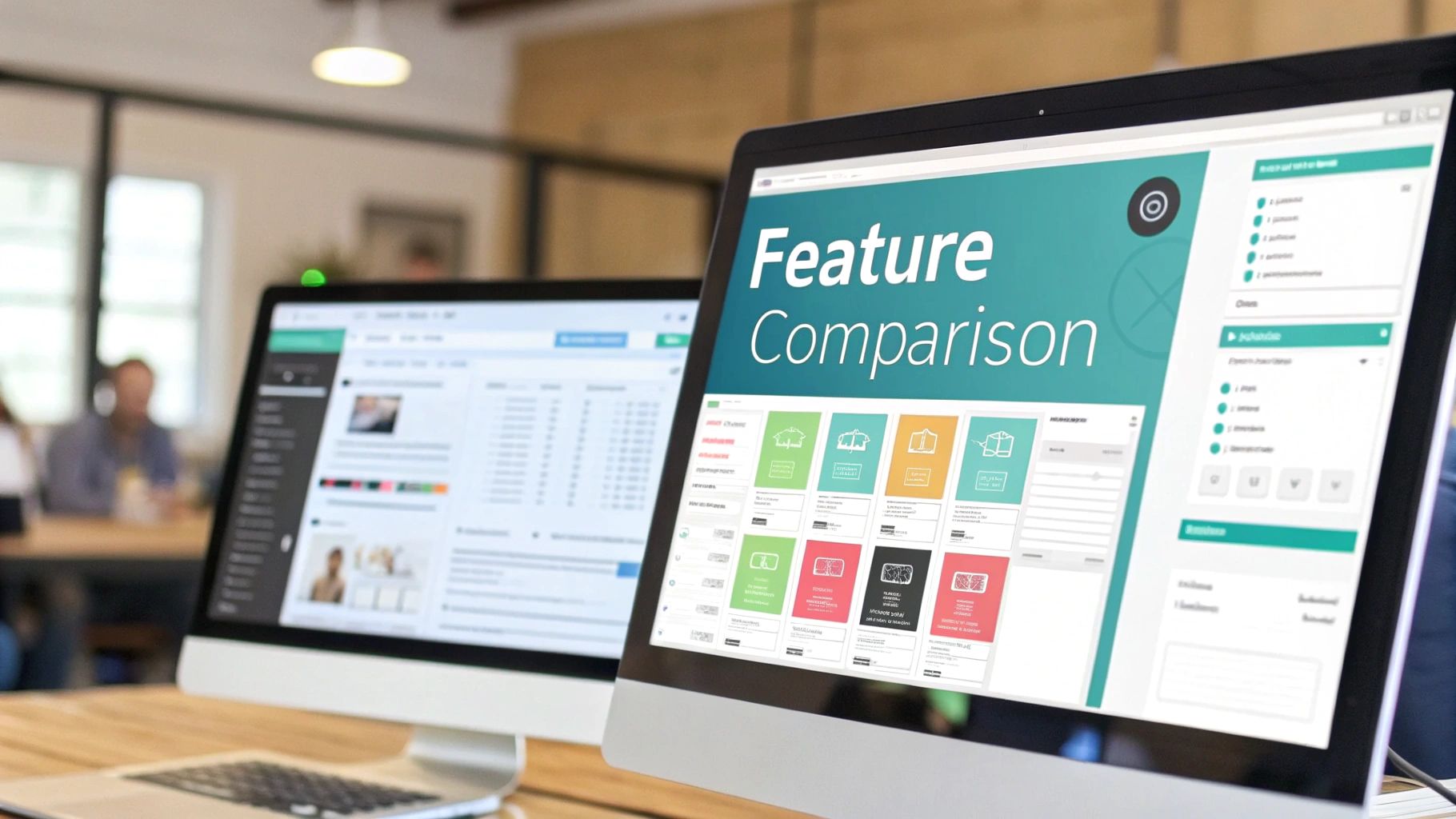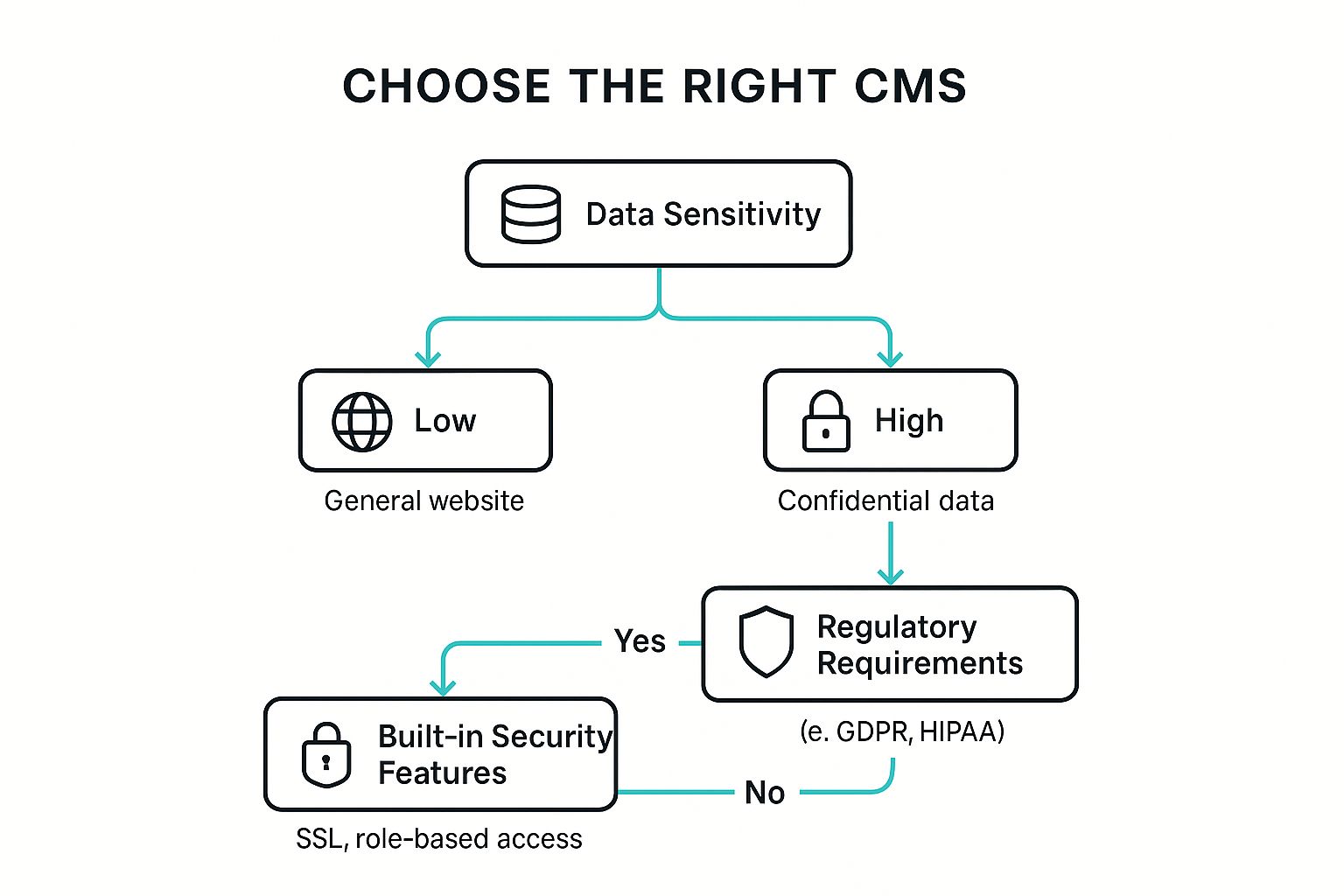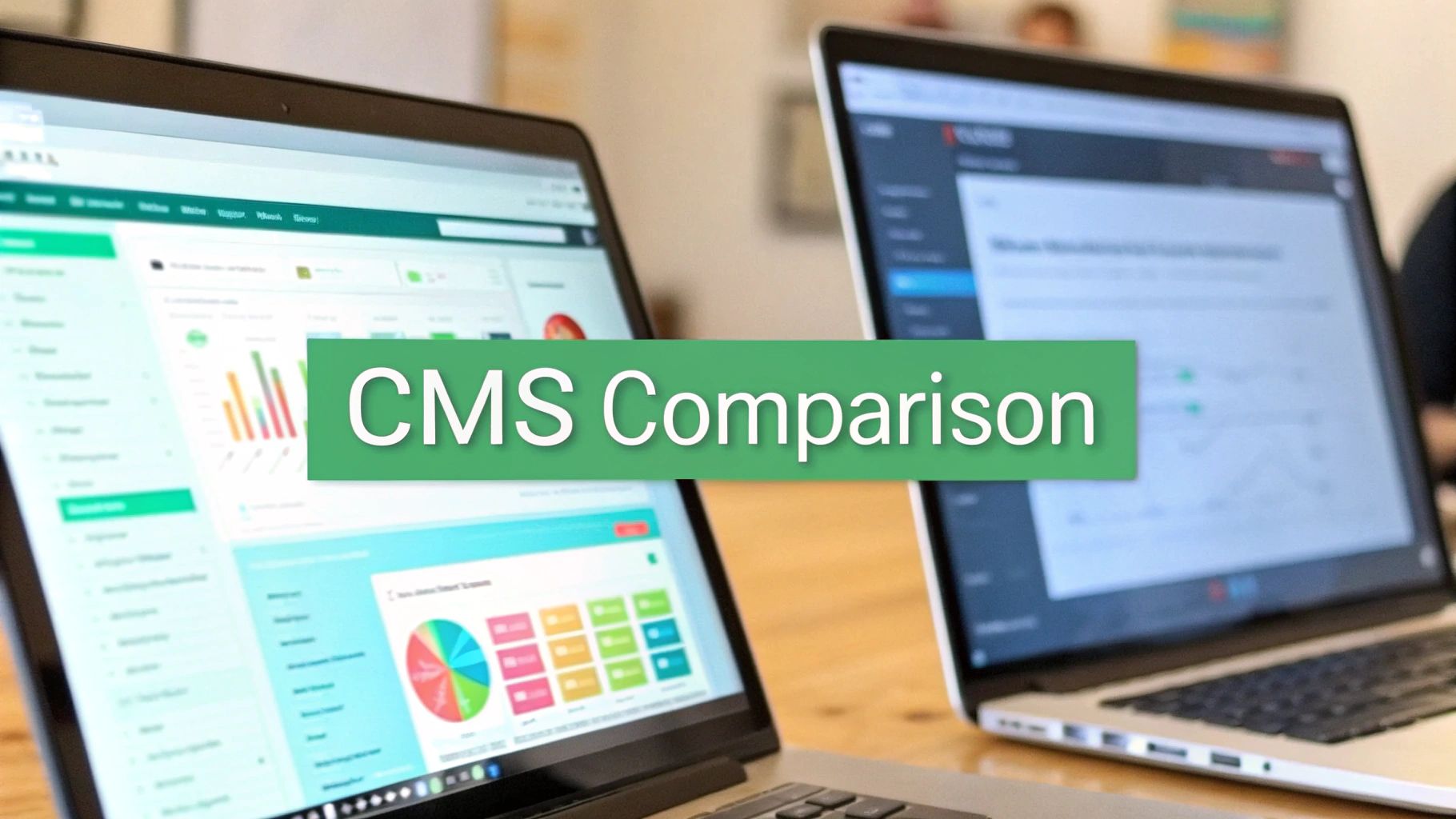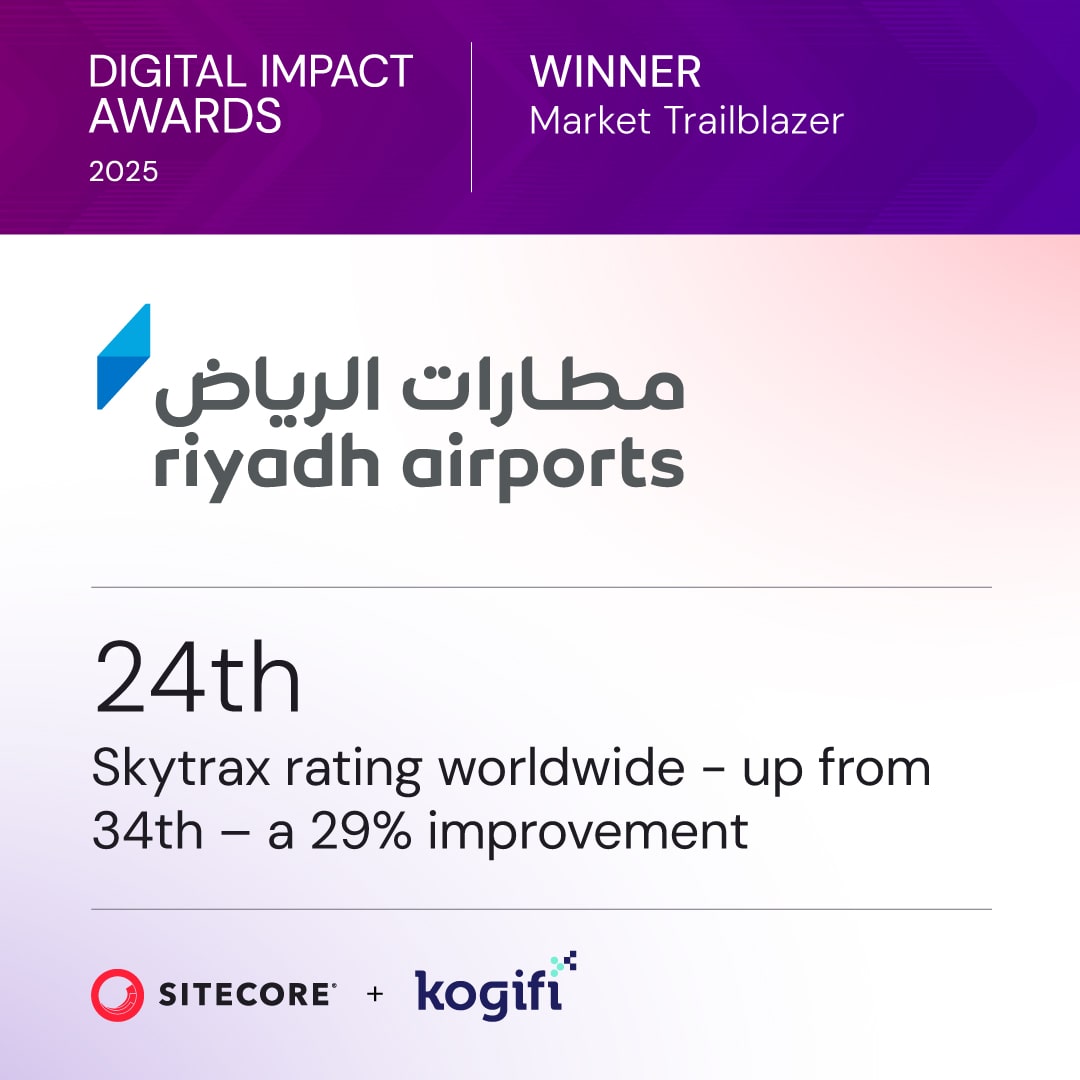Picking an enterprise content management system is one of those foundational business decisions that ripples out, affecting way more than just your content. This guide provides a deep expert comparison of two leading enterprise platforms, Sitecore and Microsoft SharePoint, to help you determine which one truly aligns with your long-term strategic vision.
Choosing Your Enterprise Digital Foundation
When you choose an enterprise CMS, you're really laying the groundwork for how your company will operate for years to come. It’s a decision that shapes everything from how your teams share knowledge internally to how you connect with customers and scale your digital presence.
At its core, this is a choice between a platform built for internal collaboration and one engineered from the ground up to create compelling customer experiences. We'll go beyond the typical feature lists to get at the heart of their architectural philosophies and what business problems they're truly designed to solve.
The Strategic Divide
Sitecore's composable Digital Experience Platform (DXP) is engineered for ambitious marketing and commerce. With a powerful product portfolio including Sitecore Personalize for real-time decisioning and OrderCloud for complex B2B commerce, it’s designed to help you deliver highly personalized, one-to-one customer journeys across every conceivable channel.
On the other hand, SharePoint is the master of internal operations. It excels at document management, building powerful corporate intranets, and streamlining how your teams work together, thanks to its deep integration with the entire Microsoft 365 suite.
The real difference isn't just about features; it's about intent. Sitecore is an engine for winning and keeping customers. SharePoint is a framework for making your organization more efficient and collaborative.
The enterprise content management (ECM) market is booming, expected to jump from around USD 26.19 billion to a staggering USD 136.47 billion by 2025. This explosion shows just how critical it is for businesses to pick platforms that can keep up.
Before you go any further, you need to answer one key question: Are you trying to perfect your internal workflows, or are you aiming to build an unbeatable customer experience?
While looking at traditional CMS and DXP platforms, it's also smart to keep an eye on broader trends shaping enterprise software. For a different perspective, check out these insights on the future of open-source no-code enterprise software.
Why Enterprises Are Moving From CMS to DXP

The traditional content management system used to be the star of the show, but for enterprises with serious growth plans, it’s just not enough anymore. A CMS is fantastic at its core job—managing and publishing web content—but that’s only one piece of a much larger puzzle. Today's customer journey is fragmented across dozens of touchpoints, from apps and social media to IoT devices and even in-store displays.
Legacy CMS platforms were built for a simpler web, one where the main goal was to serve up pages to a single website. They tend to operate in a vacuum, completely cut off from the valuable customer data flowing through your CRM, e-commerce platform, and other essential business tools. This disconnect makes it nearly impossible to deliver the seamless, personalized experiences customers now demand.
The Rise of the Digital Experience Platform
This is precisely the gap a Digital Experience Platform (DXP) is designed to fill. A DXP is more than just a beefed-up CMS; it’s a completely different way of thinking. The focus shifts from simply managing content to orchestrating the entire customer experience from end to end.
A true DXP combines core content management features with a suite of powerful tools built to understand and react to customer behavior in the moment. These platforms are architected from the ground up to break down data silos, giving you a single, unified view of each customer.
So, what really sets a DXP apart from a traditional CMS? It comes down to a few key components:
- Advanced Personalization Engines: We're talking about more than just swapping out a headline. These engines use sophisticated rules and AI to deliver true 1:1 experiences based on an individual's behavior, purchase history, and real-time context.
- Integrated Customer Data Platform (CDP): Think of the CDP as the heart of the DXP. It pulls in customer data from every single source—online and offline—to build a persistent, unified profile for every person who interacts with your brand.
- Composable Architecture: Modern DXPs, especially from leaders like Sitecore, are built on a decoupled, API-first model. This gives you the freedom to pick and choose the best tools for each job (commerce, marketing, analytics) and plug them together seamlessly.
The core idea behind a DXP is to transform a static website into a dynamic, intelligent hub for all customer interactions. It’s about creating a conversation, not just publishing a page.
Sitecore's Composable Vision
Sitecore is a prime example of this modern approach in action. Their product suite—including XM Cloud, Sitecore CDP, and Sitecore Personalize—comes together to form a powerful composable DXP. This structure gives large organizations the agility to build and scale their digital capabilities without being trapped in a rigid, all-in-one system. This kind of shift often means embracing modern architectural patterns, like those covered in this excellent guide on Mastering Microservices Architecture Design Patterns.
This is a critical distinction to make in any serious CMS evaluation. While a platform like SharePoint can be extended, it was not fundamentally architected for the intense data integration and personalization needs of a global enterprise. A DXP, by contrast, is engineered specifically to handle these complexities securely and efficiently from the start.
A Closer Look at the Sitecore Platform

When you dig into Sitecore, you quickly realize it's not a single product. It's an entire ecosystem of powerful, interconnected tools. This collection of software makes up a composable Digital Experience Platform (DXP) that helps businesses go beyond just publishing content and start orchestrating genuine customer experiences. The real value isn't in any one feature but in how all these pieces work together to hit business goals.
The platform's heart is a sophisticated personalization engine built to deliver true one-to-one experiences at scale. This is much more than just segmenting your audience. Sitecore uses a mix of marketer-defined rules and AI-driven analysis to understand what a user is doing, guess their intent, and serve up the perfect content or offer right at that moment.
The Power of a Unified Customer Profile
What makes this level of personalization possible? The Sitecore Customer Data Platform (CDP). Its main job is to fix the age-old problem of customer data being scattered everywhere. The CDP pulls in information from every touchpoint—website clicks, app usage, CRM notes, even in-store purchases—and stitches it all together into a single, comprehensive customer profile.
This 360-degree view is the bedrock for any meaningful engagement. Instead of seeing an anonymous visitor, marketers can see a person's entire history with the brand, which allows for interactions that are both relevant and contextual. In an era of tightening privacy rules and the slow death of third-party cookies, the ability to collect and unify first-party data is a massive advantage.
The key business benefit of the Sitecore CDP is its power to transform messy, raw data into a clear, real-time understanding of each customer. This unified profile is the fuel that makes true personalization possible across the entire DXP.
Turning Data into Action with Real-Time Decisions
Once the CDP has built that unified profile, Sitecore Personalize is what puts the data to work. This is the platform's real-time decision-making and testing engine. It gives marketers the power to set up complex personalization rules, run A/B tests, and create triggered experiences without needing to get a developer involved.
Think about it: a returning visitor just spent time browsing a specific product category. With Sitecore Personalize, you can instantly:
- Change the homepage hero banner to feature that same category.
- Pop up a special offer tied to those products.
- Suggest complementary items based on what similar users have bought.
All of this happens in milliseconds, creating a smooth, responsive journey that adapts to each individual. By connecting data (CDP) with action (Personalize), businesses can directly impact key metrics like conversion rates, average order value, and customer loyalty. The platform doesn't just deliver these experiences; it gives you the tools to test and fine-tune them for the best possible results.
Architecting Composable Commerce
For large businesses with complex sales needs, Sitecore OrderCloud is the peak of what composable commerce can be. It's a headless, API-first commerce platform built for the kind of B2B, B2C, and B2X scenarios that off-the-shelf solutions just can't handle. Its main strength is its incredible flexibility.
OrderCloud keeps the back-end commerce logic—things like pricing, inventory, and order management—separate from the front-end user experience. This means companies can build completely unique storefronts on any channel they want, whether it’s a website, a mobile app, a kiosk, or an IoT device, all powered by a robust, centralized commerce engine. It's a perfect fit for businesses with tricky rules, like custom pricing for different customer groups, complicated approval workflows, or multi-vendor marketplace models.
Ultimately, you can see how Sitecore’s products are designed to be more than the sum of their parts. The synergy between its CDP, personalization engine, and commerce tools gives enterprises everything they need to not just manage content, but to build and optimize the entire customer journey. It turns a complex technical setup into clear, measurable business wins.
Understanding SharePoint In The Enterprise

While Sitecore is all about crafting compelling external digital experiences, Microsoft SharePoint dominates the enterprise world for an entirely different reason. It’s not really a tool for marketers trying to win new customers. Instead, think of it as the operational engine room—a platform built from the ground up for internal efficiency and knowledge management. Grasping this core difference is the first step in any real CMS comparison.
At its heart, SharePoint acts as a secure, central hub for everything that happens inside a company. It's the digital equivalent of the corporate headquarters, where teams collaborate, documents live under lock and key, and critical information flows through sophisticated intranets.
The entire platform is wired for collaboration. You've got team sites with shared calendars and to-do lists, intricate document libraries with version control, and complex approval workflows. Every feature is there to help people work together more smoothly.
The Power Of Native Microsoft 365 Integration
SharePoint’s true superpower is how deeply it's woven into the Microsoft 365 ecosystem. This isn't just a simple add-on; it's a symbiotic relationship where SharePoint serves as the content and data backbone for a dozen other Microsoft tools.
This tight integration creates an internal productivity powerhouse that’s incredibly difficult for any standalone platform to match. Processes that would normally demand clunky, third-party workarounds are just handled natively, right out of the box.
Let’s look at a few everyday examples:
- Microsoft Teams: When you drop a file into a Teams chat, you're not just sending an attachment. That file is automatically stored in a SharePoint document library, giving it enterprise-grade security and version history without you even thinking about it.
- OneDrive: Your personal OneDrive for Business is actually your own little SharePoint site collection. It gives you a simple, familiar interface while ensuring all your work stays safe and compliant within the Microsoft cloud.
- Power Platform: A business analyst can fire up Power BI and create live, interactive dashboards pulling data straight from a SharePoint list. Or, someone could use Power Automate to build a complex workflow that kicks off the moment a document is approved in a SharePoint library.
SharePoint isn't just another app in the Microsoft suite; it's the foundational content service that powers collaboration across the entire ecosystem. This native integration is its key competitive advantage for internal enterprise use cases.
Moving an organization into this highly integrated world can come with its own set of challenges. For anyone planning this kind of shift, it pays to know what you're up against. You can dive deeper into the most frequent roadblocks by reading about common SharePoint migration challenges and expert solutions.
Assessing SharePoint For Public-Facing Websites
So, with all these robust content features, can you use SharePoint to build a public, customer-facing website? Technically, yes. SharePoint Online has modern communication site templates that you can open up to the outside world.
But when you get practical, the limitations become obvious, especially when you compare it to a dedicated DXP like Sitecore. SharePoint’s DNA is all about internal users and controlled access; it simply lacks the sophisticated toolkit needed for modern digital marketing. It wasn't designed to track anonymous visitors, build rich customer profiles, or deliver personalized content based on what someone is doing on your site right now.
Here are a few key marketing tools that are standard in a DXP but are either missing or very basic in SharePoint:
- Advanced Personalization: SharePoint can show different content to different internal user groups, but it can’t change what it shows based on the behavior of an unknown visitor from the internet.
- A/B and Multivariate Testing: There are no built-in features for testing one headline against another to see which one converts better.
- Integrated Marketing Automation: Trying to connect a visitor’s click on a SharePoint site to an automated email nurture campaign is a complex, often custom-built, ordeal.
When it comes down to it, SharePoint knows its role. It’s an absolute beast for building powerful corporate intranets, managing documents with an iron fist, and getting internal teams to collaborate effectively. While it can serve up a basic public webpage, it's not a true competitor to a DXP when your business goals revolve around customer acquisition and engagement. It excels as an internal productivity engine, leaving the art of the customer experience to platforms built for that purpose.
When to Choose Sitecore vs SharePoint
Deciding between Sitecore and SharePoint isn't about which one has a longer feature list. It's about getting to the heart of what you need to accomplish. One is a powerhouse for driving customer engagement and revenue through sophisticated marketing, while the other is purpose-built to organize internal teams and lock down corporate knowledge.
To make the right call, you have to match your specific business challenge to the platform's fundamental design. Let’s break down a few common scenarios to see why one is a better fit than the other, connecting their core capabilities directly to real-world goals.
This decision tree helps visualize how data security and regulatory needs can steer your choice.

As the infographic shows, the more sensitive your data and the stricter your compliance rules, the more critical a platform's built-in security framework becomes in your decision.
Scenario 1: Launching a Global B2C Marketing Site
Your mission is to roll out a flagship website for a global consumer brand. The main goals are clear: drive engagement with personalized content, lift conversions with A/B testing, and build a complete customer profile by tracking behavior across every digital channel.
Recommendation: Sitecore
This is a slam dunk for Sitecore. Its entire product suite, from the Sitecore CDP to Sitecore Personalize, was created for this exact challenge. You can build out complex personalization rules based on a visitor's location, browsing history, and past purchases to deliver a truly one-to-one experience.
If your business lives and breathes customer acquisition, conversion optimization, and lifetime value, Sitecore’s DXP capabilities give you the entire toolkit. SharePoint simply doesn't have the native marketing automation or deep analytics needed to play in this space.
On top of that, Sitecore's composable architecture lets you plug in best-in-class marketing and commerce tools, giving you a flexible tech stack that can grow with you. Understanding this architectural difference is key; you can dig deeper by learning how to choose between open-source and proprietary CMS.
Scenario 2: Developing a Secure Corporate Intranet
Here, the task is to build a secure, central hub for thousands of employees spread across different departments. The system needs to handle document management with version control, make team collaboration seamless, and integrate perfectly with tools everyone already uses, like email and chat.
Recommendation: SharePoint
This is SharePoint's home turf. Its greatest strength is its deep, out-of-the-box integration with the Microsoft 365 ecosystem. Document libraries, team sites, and communication portals work hand-in-glove with Microsoft Teams, OneDrive, and Outlook, creating a single, unified digital workplace.
Its security model is built on Azure Active Directory, giving you fine-grained control over who can see and do what—an absolute must for protecting sensitive company information. Trying to build this level of internal integration and security with a marketing DXP like Sitecore would be a massive, expensive, and unnecessary headache.
Scenario 3: Building a Headless B2B Commerce Experience
Your company needs a complex B2B e-commerce platform. We're talking about a massive product catalog, customer-specific pricing, intricate approval workflows, and maybe even multi-vendor marketplace features. The front-end experience also needs to be delivered "headless" to a web portal, a mobile app, and partner sites.
Recommendation: Sitecore
Sitecore, especially with its Sitecore OrderCloud product, was engineered for these exact kinds of complex, headless commerce builds. OrderCloud is an API-first platform, which gives you the flexibility to model virtually any B2B business logic, no matter how unique. Its headless design means your developers can create any front-end experience imaginable, all powered by one incredibly robust commerce engine.
SharePoint just isn't built for this. It can't handle the transactional complexity or the headless delivery required for a modern B2B commerce operation. Its focus is content and collaboration, not managing sophisticated ordering and fulfillment. For ambitious e-commerce projects, Sitecore’s specialized tools give it a massive lead.
Platform Suitability by Enterprise Use Case
To make the choice even clearer, this table maps common business needs to the ideal platform, highlighting why each one excels in its respective domain.
Ultimately, your primary objective should be the deciding factor. If your goal is to win and retain customers online, Sitecore is the clear choice. If you need to empower and organize your internal teams, SharePoint is the answer.
Answering Your Burning Platform Questions
When you're comparing two major platforms like Sitecore and SharePoint, the final decision often boils down to a few practical, make-or-break questions. You have to move past the feature lists and get into the reality of implementation. This is where the right choice usually becomes crystal clear. Let’s tackle some common questions, focusing on what really separates these two systems.
Can You Really Use SharePoint for a Public Website?
The short answer is yes, you technically can. SharePoint Online has templates for public-facing sites, and you can certainly get one up and running. But that's missing the point. SharePoint was built from the ground up for internal collaboration—it’s a document management and intranet powerhouse.
If your goals are centered on serious customer engagement—think deep personalization, A/B testing, marketing automation, and sophisticated analytics—you’re trying to fit a square peg in a round hole. For that, you need a true Digital Experience Platform (DXP) like Sitecore. SharePoint sites are a great fit for simple informational portals or partner extranets where you don't need to track the customer journey or optimize for conversions.
Using SharePoint for a public-facing marketing site is like taking a reliable cargo truck to a Formula 1 race. Sure, it’ll get around the track, but it was never designed to win. Sitecore is the purpose-built race car, engineered for speed, agility, and performance.
What Does "Composable DXP" Actually Mean for Sitecore?
"Composable DXP" is a modern approach to building your tech stack. Instead of buying one massive, all-in-one platform, you assemble your ideal setup from best-in-class, interchangeable tools that talk to each other. For Sitecore, this means their key products—like XM Cloud, Sitecore CDP, and Sitecore Personalize—are designed to be adopted individually.
This gives you incredible flexibility. You can pick and choose the exact capabilities you need right now and integrate them with the systems you already use. It helps you avoid getting locked into a single vendor's ecosystem. As your needs change or better technology comes along, you can just swap out a component. It’s a strategic move away from monolithic software toward a more agile, custom-fit solution.
How Do Sitecore and SharePoint Handle Integrations?
Both platforms are integration-friendly, but they come at it from completely different worlds. SharePoint's strength is its deep, native connection to the Microsoft ecosystem. It works flawlessly with tools like Dynamics 365, Power BI, and Microsoft Teams, making it an unbeatable hub for internal productivity.
Sitecore, on the other hand, was built to be the central nervous system for your marketing efforts. It has a huge library of pre-built connectors and a powerful API-first design that lets it talk to almost anything:
- CRM platforms like Salesforce
- Enterprise Resource Planning (ERP) systems
- The entire universe of third-party marketing and analytics tools
Sitecore's xConnect API is specifically designed to pull customer data from all these different places into its own Customer Data Platform. This is how you build a true 360-degree view of your customer, which is the absolute bedrock of effective personalization.
How Does the Total Cost of Ownership Really Compare?
This is where things get interesting, because you can't just look at the sticker price. SharePoint Online is often bundled into Microsoft 365 E3 or E5 licenses, so the initial cost can seem very low, or even free if you already have the subscription.
But the real cost for a public SharePoint site can creep up on you. Any significant customization, custom development to add marketing features, or integration with non-Microsoft tools will add serious expenses down the line.
Sitecore is an enterprise platform, and it comes with a premium price tag. The upfront licensing costs are higher, no question. But you have to weigh that against the potential Return on Investment (ROI). Its features are all built to directly grow revenue, boost customer loyalty, and increase conversions.
A Quick Cost Breakdown by Situation:
- For Internal Collaboration: SharePoint is almost always the more cost-effective choice. The bundling and native integrations with tools your team already uses give it a much lower TCO.
- For Revenue-Generating Digital Experiences: Sitecore's higher cost is often justified because its tools can deliver a measurable lift in key business metrics. The investment is directly tied to its ability to build more profitable customer relationships.
In the end, it all comes down to what you're trying to achieve. For boosting internal efficiency, SharePoint is the smart, cost-effective play. For creating a market-leading customer experience that drives your bottom line, Sitecore provides the specialized power to make the investment pay off.
At Kogifi, we specialize in implementing and optimizing enterprise-grade digital platforms that drive measurable business results. If you're ready to build a digital experience that truly connects with your customers, let's talk. Learn more about our expert services at Kogifi.com.








































